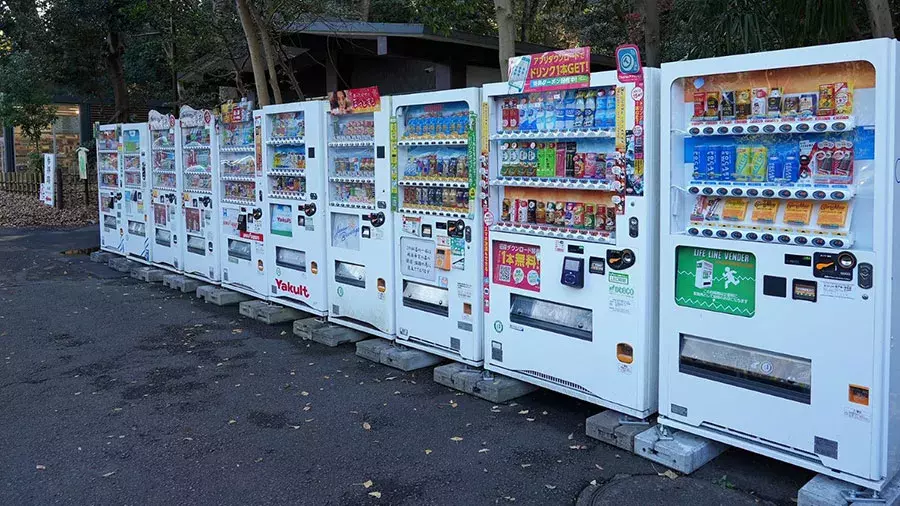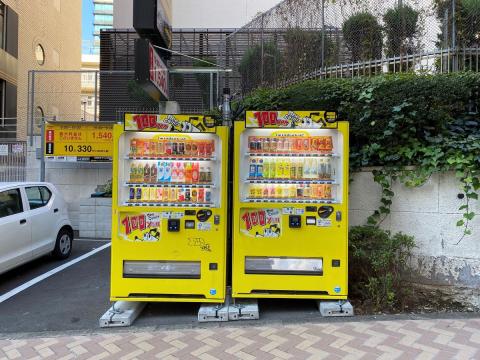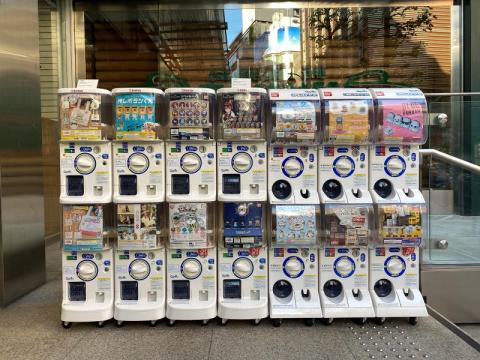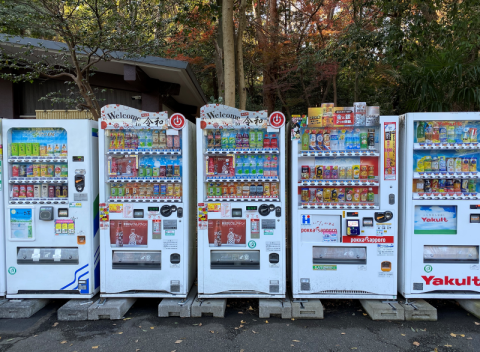
After a long day on the go, for many there is perhaps no sound as reassuring as the “CLUNK!” of a refreshing drink dropping into the slot of a vending machine. From airports to train stations, school campuses to hospitals, offices to sports clubs, the simple vending machine is one of the great inventions of the modern age. But though they are found all over the world, vending machines have an extra special place in the Japanese landscape, and have come to have their own distinct culture.
Today, there are approximately 4.15 million vending machines in Japan, which means approximately one for every 30 people – by far the highest ratio for any nation in the world. Foreign visitors often marvel at not only the number of vending machines in Japan, but also at their quality (clean and functioning), the wide variety of goods sold, and other ways they are integrated into daily life. How did vending machines become so prominent and beloved in Japan, leading some to call the country a “vending machine heaven”?

Though the vending machine wasn’t invented in Japan, the love affair certainly started long ago. The ancient roots of the vending machine can be seen in the story of Hero of Alexandria, an engineer and mathematician in 1st-century Egypt, who supposedly created a machine that dispensed holy water from a spout in exchange for a coin. More recognizable coin-operated machines started to emerge in 17th century England, such as those vending tobacco in taverns (with some human assistance). The first fully-automated vending machine was patented in England by Simeon Denham in 1867, and the concept spread to Germany and the U.S. as early chocolate and gum dispensing machines. In 1888, a patent was filed by Koshichi Tawaraya in Japan for an “automatic goods vending machine”. His first iteration dispensed tobacco, but he continued inventing others including a machine that sold wooden stamps and cards (this is the oldest surviving vending machine in Japan, now on display in Tokyo’s Postal Museum).
From there, vending machines (or jidōhanbaiki, 自動販売機) continued to integrate into the urban landscape with diversified product lines, and adding new design innovations. In the 1920s, machines selling candy became prevalent and by the 1950s, fruit juice machines rose in popularity. But it was in the 1970s that a particular stroke of engineering genius became a tipping point. Japan’s first canned coffee had appeared in the 1960s, and a decade later, the Pokka brand introduced the first “hot and cold” dual temperature vending machine allowing patrons to buy icy drinks in summer and warm ones in the winter. This technical invention made vending machines even more widespread across the nation, as products on offer expanded to include almost everything under the sun.
Today, one can’t walk more than a few blocks in any Japanese city (or drive a few minutes in the countryside) without spotting a machine vending something – from the typical candy, snacks, and beverages, to something more esoteric. Need a hot meal? Some vending machines dispense an entire dinner (similar to the “automat” machines that were a staple of 1950s America but have since disappeared). Jonesing for a cute and collectible toy? Track down a “gachapon” or toy vending machine featuring anime and other characters (which have now been popularized abroad). Seeking spiritual knowledge? Some temples have adopted vending machines to dispense the traditional fortune-telling paper slips (omikuji) in exchange for an offering. Clothing, cosmetics, newspapers, electronics, umbrellas, flower bouquets, organic produce, even live lobsters – the list goes on and on. Most of these items are accessible to any passersby with a coin (or IC Card) in their pocket, but a few machines have become age-restricted in recent years, such as for cigarettes and alcoholic beverages.

What is perhaps even more amazing than the unparalleled variety of products sold is how vending machines are an integral part of daily life in Japan – and how they reflect unique aspects of culture, economy, and demographics. For one, due to low rates of crime, vending machine operators are confident placing (and diligently maintaining) machines literally any place, from dark alleys to remote agricultural areas, knowing they won’t be vandalized or broken. In cities, high real estate prices mean vending machines are often a better business investment for a retailer or beverage company compared to renting an entire shop or convenience store (konbini) – the profit per square foot is far higher. On the flip side, in sparsely populated rural areas where it would be cost-prohibitive to staff a shop with employees full-time, vending machines are a good alternative to allow residents to easily and affordably access goods.
Of course, many features of Japanese contemporary life prioritize efficiency and convenience. On a given block, there may be a bank of vending machines right next to a konbini. What makes vending machines even more convenient than a convenience store? Due to deep traditions of cultural etiquette, convenience stores involve a more ritualized greeting and encounter with a shop clerk beyond a mere transaction – whereas nobody worries about offending a vending machine. Scholars have also theorized that while in the West, machines and technology are regarded with inherent suspicion, in Japan they are more easily embraced. Therefore service technology, up to and including robots, is seen as a warm complement to modern life, not a cold dehumanization of it.

Of course, vending machines are a commercial endeavor, and they have particularly thrived because of a long-standing cash economy. Even subconsciously, the weight of accumulated 100 yen coins in your pocket might nudge you to get rid of them in exchange for a bottle of juice or packet of Pocky. In recent years, most vending machines are equipped with readers for IC (integrated circuits) cards such as Suica, Pasmo, or Icoca. Will this change the number of “impulse” purchases? And how is the rise of online shopping and changing consumer patterns impacting vending machines?
To address these challenges, vending machine operators are adapting to the times. Innovations include reducing power usage (electricity usage has been cut by 50% since the late 1990s), utilizing social media (some machines will recognize the customer by their IC card and suggest their favorite snack), and dispensing drinks and other goods for free during emergencies and natural disasters. Recently, schools in Ibaraki Prefecture set up special free vending machines to dispense cold water to help prevent heat stroke during hot weather, and generally promote health amidst the coronavirus pandemic.
Even during ordinary times, the vending machine is a humble yet essential part of Japan’s infrastructure. They may not be as heroic as the trains that stitched the nation together, but they are as crucial to the work and life of millions of everyday people. And even the most old-fashioned analogue machine still provides a sense of childlike wonder if we stop to notice it. Slide the coin into the slot, push the button, listen to the gears turning, and watch your chosen treasure dropping down behind the swinging door, waiting for you. Just like magic.

